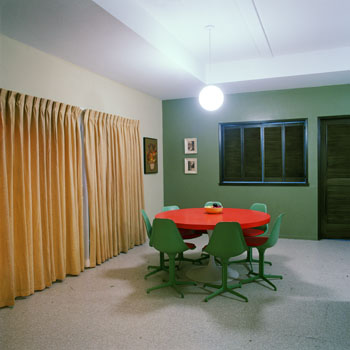|
Review by Jody Zellen
Artpapers September/October 2003
John Divola
X-Files
Patricia Faure Gallery
May 10 - June 14, 2003
John Divola is a thoughtful photographer whose work investigates different
manifestations of desire. Past bodies of work have included photographs
of isolated desert houses where Divola was interested in the desire to
be outside or beyond culture, and panoramic images depicting unpopulated
streets of Los Angeles that focused on generic buildings housing churches,
adult book stores, and bars. According to Divola, "these buildings
are places that people go to looking for physical or mental change or
an intensity of experience. There is some sort of resonance between the
depth of these desires and the mundane and generic look of the buildings
that promise to fulfill them."
His recent exhibition, "X-Files," contains two bodies of work.
One, large-scale, color photographs taken by Divola on the set of the
TV show The X-Files during its final season; the other, 8x10, B+W found
movie stills from the 1930’s - 60’s depicting faux nature. Here
we see stage sets of mountains and snow, realistic trees with painted
backdrops, against which actors might play their dramatic roles. These
photographs point to another time when we were not accustomed to high
tech special effects, we were able to suspend disbelief.
The TV phenomenon The X-Files was about desire. The show was motivated
by the slogan "the Truth is out there." But what truth? Television
programs, even so-called ‘reality’ shows, are not truths. They
are fabrications, staged events. So was The X-Files, and so is photography.
In Divola’s "X-Files," there are no images of Moulder and
Scully. The stars are not there. The images are unpopulated. The sets
are bare. In fact, the sets are in disarray, fragments built for the camera,
not even finished in many instances. These sets are not glamorous or pretty.
In contrast to the nostalgic and romantized found photographs, Divola’s
X-Files images are purposefully dry and awkwardly framed.
Divola’s photographs depict the remains of an office, long hallways,
empty rooms. Included in Divola’s images are photographs of a TV
show looking back at a TV show, sets from an X-Files episode that was
filmed in a re-make of ‘The Brady Bunch’ house. In this episode
there was an investigation of a man who appeared to have telekinetic powers
and was obsessed with ‘The Brady Bunch.’ ‘The Brady Bunch’
was recognizable to all X-Files viewers as an icon of a specific time
and attitude in television viewing. Divola’s images undermine our
expectations. All that is left of the set are the green chairs and orange
dinning room table. This modernist décor is complete with shag
carpet and a Van Gogh-esque painting. Divola presents numerous views of
this setting, each shot from a different perspective. These different
views should give us more information but they do not. Yet we try to remember.
We want to know both what the original house looked like as well as what
happened in the X-Files episode. We project our desire and our memory
onto these images, unsuccessfully.
The X-Files was a place to watch our fears and desires unfold. We root
for the heroes. We want the answers. We believe in the conspiracy. We
are sure the truth is out there. But the truth was a fabrication. What
truth is out there? Divola is looking for ‘evidence of existential
desire’ that exists in both the real and the fabricated world and
his images map our desire by presenting objective documentation of the
sites of our projections. What lies beyond the frame? Does it exist? That
which exists beyond the frame, that which Divola has no control over –
memory, desire, and fantasy - is subject of his quest.
Jody Zellen
|
|
